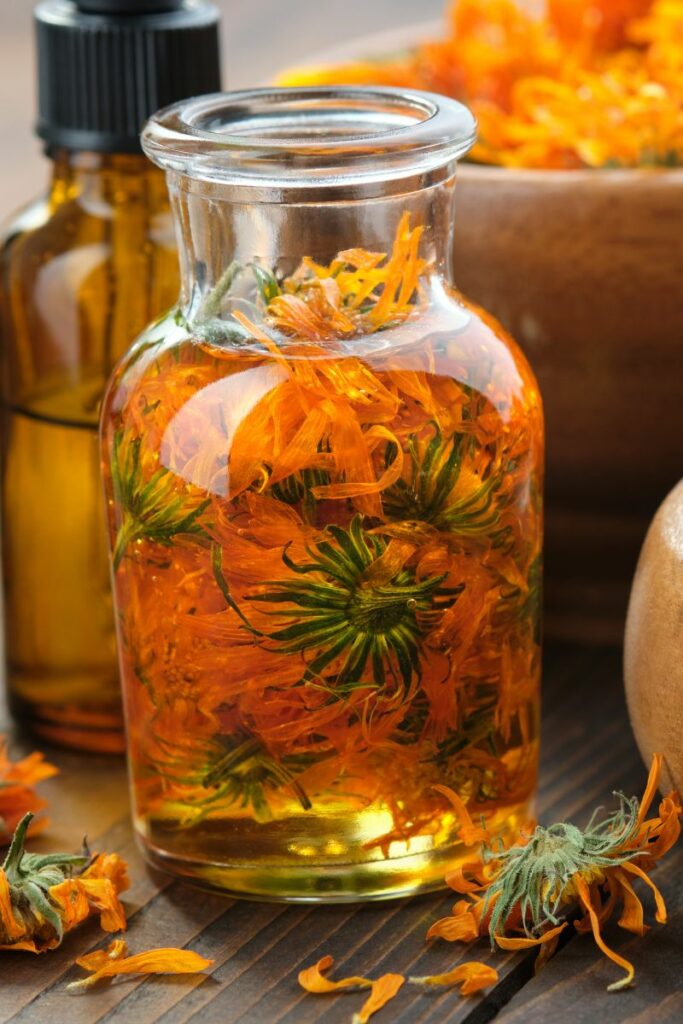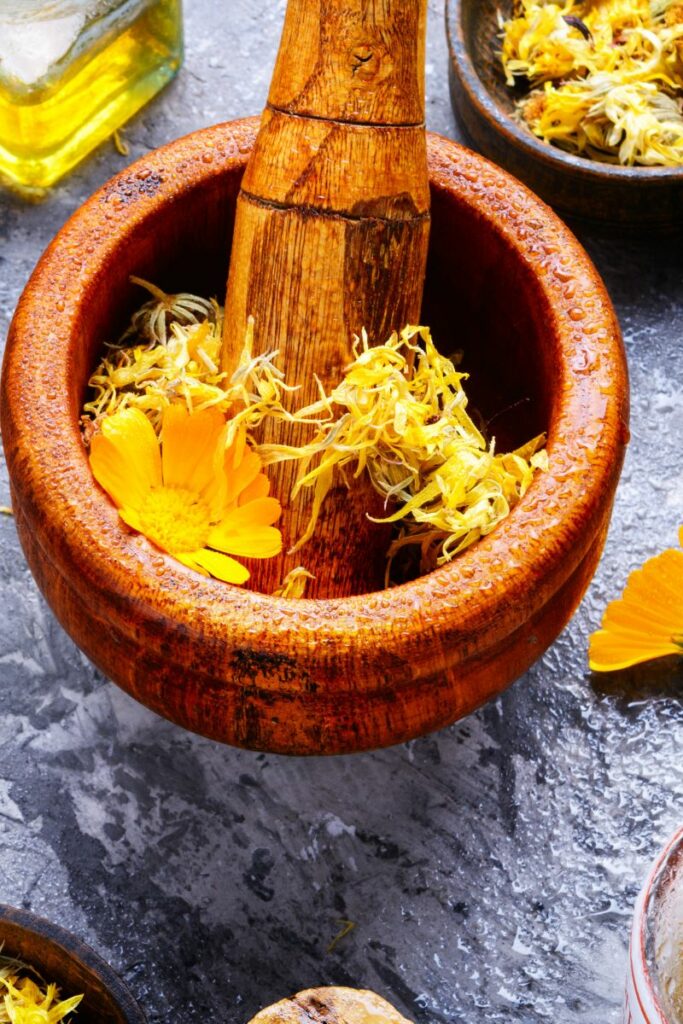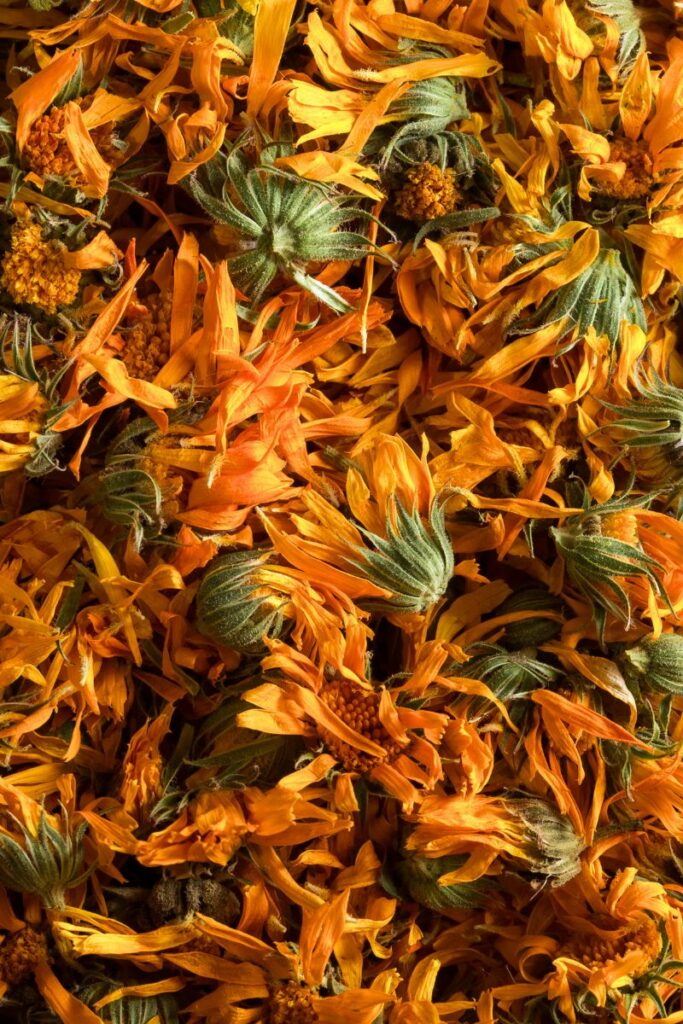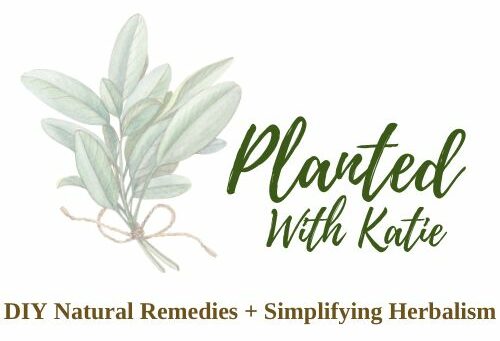7 Health Benefits of Calendula + How To Use It
Today, we’re diving into the health benefits of Calendula, also known as pot marigold. This bright and beautiful flowering plant is more than just a pretty face in your garden. It’s a powerful herb used in many natural remedies.

Calendula, a member of the Asteraceae family (also called the aster family or compositae family), has been cherished for centuries for its medicinal uses. Its vibrant orange and yellow blossoms, called calendula flowers or calendula petals, are packed with healing properties. These flowers can be used fresh or dried and made into a variety of calendula products, including creams, oils, and ointments.
In this blog, I’ll share seven amazing health benefits of calendula and show you how to use it in your daily life. We’ll talk about everything from its role in soothing skin irritation and protecting against sun damage to its potential in supporting cancer treatment and promoting oral health. I’ll also give you tips on how to prepare calendula at home and incorporate it into your skincare routine.
So, get ready to learn all about the healing powers of this fantastic plant and how you can harness its benefits. Let’s get started!
What is Calendula?
Calendula, also known as pot marigold or by its scientific name, Calendula officinalis L., is a flowering plant that belongs to the Asteraceae family (sometimes called the aster family or compositae family). You might spot it in vegetable gardens or even growing wild. Its bright yellow and orange petals make it easy to recognize.

Description of the Calendula Plant
Calendula is a tough little plant that loves well-drained soil and sunny spots. It can grow up to 20 inches tall and has daisy-like flowers that bloom all summer long. The flower heads, also called calendula blossoms, are where the magic happens. These are the parts used in many medicinal preparations.
Historical Uses and Origins
Calendula has been used in herbal medicine for centuries. Ancient Egyptians, Greeks, and Romans valued it for its healing properties. They used it to treat various skin conditions, wounds, and even menstrual cramps. In the Middle Ages, people believed it could ward off evil and used it in cooking and as a dye.
Over time, calendula's medicinal uses expanded. It's known for its anti-inflammatory activity, antibacterial properties, and ability to support the immune system. Calendula is often used as a natural remedy for skin irritation, chronic inflammation, and sore throats.
Common Ways To Use Calendula
Calendula can be prepared in many ways. Here are some of the most common forms:
- Calendula Cream and Ointment: These are popular for topical use. They can soothe skin issues like rashes, burns, and eczema. Calendula ointment is also great for diaper rash creams.
- Calendula Oil: Made by infusing calendula petals in a carrier oil like olive oil, jojoba oil, or coconut oil. This oil is used in skincare products and as a base for other calendula products.
- Calendula Tea: Made by steeping dried calendula flowers in hot water. This tea is thought to help with sore throats and digestive issues.
- Calendula Tincture and Extract: These are concentrated forms used in various medicinal preparations. A single test-tube study showed that calendula extract could help fight harmful effects of oxidative stress.
With so many forms and uses, calendula is a versatile and powerful addition to your natural products collection. Next, we'll explore the specific health benefits of calendula and how you can use it to support your well-being.
Top 7 Health Benefits of Calendula
1. Wound Healing
Calendula promotes faster recovery of minor cuts and scrapes. Scientific studies and evidence show that calendula contains anti-inflammatory compounds that help reduce swelling and redness. Applying calendula cream or ointment can be an effective treatment for wounds, speeding up the healing process. Always do a patch test first to ensure no allergic reaction.
2. Skin Hydration
Calendula is fantastic for moisturizing and nourishing dry skin. It’s especially ideal for sensitive skin types. You can find calendula in many skincare products like creams and oils. Mixing calendula oil with a carrier oil such as coconut oil or olive oil can help keep your skin hydrated and radiant. It’s a good idea to store your calendula oil in a dark place to keep it fresh.
3. Anti-Inflammatory Properties
Calendula reduces redness and swelling, making it effective for conditions like eczema, psoriasis, and dermatitis. The anti-inflammatory compounds in calendula are powerful. Animal studies and other scientific evidence back up the use of calendula for reducing skin inflammation. Preparations of calendula flower, such as creams or ointments, are excellent for soothing irritated skin.
4. Antimicrobial Effects
Calendula helps prevent and treat infections. It has strong antimicrobial effects, which are beneficial for acne and other skin conditions. Applying calendula ointment can help keep your skin clean and clear by fighting off harmful bacteria. Calendula's antibacterial properties make it a popular choice in herbal remedies for skin issues.
5. Antioxidant Benefits
Calendula protects the skin from free radicals, which are harmful molecules that can damage cells. The potent antioxidants in calendula enhance overall skin health. Using calendula products regularly can help maintain a youthful complexion by preventing skin damage and promoting skin regeneration.
6. Soothes Skin Irritations
Calendula is excellent for calming sunburns, rashes, and insect bites. It alleviates discomfort from diaper rash, making it a gentle and effective choice for babies. Many rash creams and soothing lotions include calendula because of its calming properties. It's also useful after a tooth extraction to help soothe irritated gums.
7. Improves Complexion
Calendula enhances skin tone and texture, helping to fade scars and blemishes. Consistent use of calendula can lead to a more even complexion and radiant skin. Products like calendula cream or essential oil can be incorporated into your skincare routine for best results. With its numerous benefits, calendula is a natural remedy that supports overall skin health and beauty.
How to Use Calendula
Calendula Oil
Preparation and Application Tips:Calendula oil is easy to make and use. Start by drying calendula flowers. Once dry, put the flowers in a jar and cover them with a carrier oil like olive oil, coconut oil, or jojoba oil. Let the jar sit in a dark place for about 4-6 weeks, shaking it occasionally. After that, strain out the flowers, and your calendula oil is ready!

DIY Recipes for Homemade Calendula Oil:
- Basic Calendula Oil:
- Fill a jar with dried calendula petals.
- Cover with your favorite carrier oil.
- Let it sit in a dark place for a few weeks, then strain.
- Calendula and Aloe Vera Oil:
- Mix calendula oil with a bit of aloe vera gel.
- This combination is great for soothing sunburns and skin irritation.
Use calendula oil to moisturize your skin, treat minor cuts, and soothe irritation. Always do a patch test first to avoid any allergic reaction.
Calendula Tea
How to Make Calendula Tea: Making calendula tea is simple. Add a tablespoon of dried calendula petals to a cup of hot water. Let it steep for about 10 minutes, then strain the petals out. Your tea is ready to drink!
Benefits of Drinking Calendula Tea: Calendula tea can help soothe sore throats, improve digestion, and support your immune system. It’s also known to have anti-inflammatory compounds that help reduce swelling and discomfort. Drinking calendula tea regularly is a good idea for overall health.

Calendula Creams and Ointments
How to Use for Skin Conditions: Calendula creams and ointments are excellent for treating various skin conditions like eczema, psoriasis, and dermatitis. They can also help heal minor wounds and prevent skin damage. Simply apply a small amount to the affected area a few times a day.
Best Practices for Application:
- Clean the skin before applying the cream or ointment.
- Use a thin layer and gently rub it in.
- For best results, use regularly as part of your skincare routine.
Calendula creams and ointments are also beneficial for sensitive individuals and babies with diaper rash.
Calendula in Cooking
Culinary Uses of Calendula: Calendula petals can add a splash of color and a mild, peppery flavor to your dishes. They’re great in salads, soups, and even baked goods. You can use fresh or dried petals.
Nutritional Benefits: Calendula petals are rich in antioxidants and vitamins, which can help boost your immune system and overall health. Adding calendula to your meals is not only a fun way to use this versatile flower but also a way to enjoy its nutritional benefits.
By incorporating calendula into your daily life, you can enjoy its many benefits, from skincare to cooking. Whether you’re using it in oils, teas, creams, or your favorite recipes, calendula is a powerful and natural remedy that supports your health and well-being.

Potential Side Effects and Precautions Of Calendula
Common Side Effects
Calendula is generally safe for most people, but like any herbal remedy, it can cause some side effects. Common side effects include:
- Skin Irritation: Some people may experience skin irritation when using calendula products, especially if they have sensitive skin. It’s a good idea to do a patch test before using any new calendula product.
- Allergic Reaction: Although rare, some individuals may have an allergic reaction to calendula, especially if they are allergic to plants in the Asteraceae family, which includes daisies and marigolds.
Who Should Avoid Using Calendula
While calendula has many benefits, there are certain groups of people who should avoid using it:
- Pregnant Women: There isn't enough reliable information about the safety of calendula for pregnant women. To be safe, pregnant women should avoid using calendula products.
- Breast Cancer Patients: People undergoing breast cancer treatment or radiation therapy should consult with their doctor before using calendula, as it may interact with certain treatments.
- People with Diabetes-Related Foot Ulcers: Although calendula can help with wound healing, people with diabetes-related foot ulcers should talk to their doctor before using calendula to ensure it won’t interfere with their current treatment.
- Individuals with Allergies: If you are allergic to plants in the Asteraceae family, avoid using calendula to prevent an allergic reaction.
Tips for Safe Usage
To safely enjoy the benefits of calendula, follow these tips:
- Do a Patch Test: Before using any new calendula product, apply a small amount to your skin and wait 24 hours to check for any reactions.
- Use Pure Calendula Products: Look for calendula products that are free from artificial additives and fragrances to reduce the risk of irritation.
- Consult Your Doctor: If you have any health conditions or are taking medication, talk to your doctor before using calendula, especially if you’re undergoing cancer treatment or have diabetes-related foot ulcers.
- Follow Instructions: Always follow the usage instructions on calendula products to avoid overuse and potential side effects.
Calendula is a wonderful natural remedy with many benefits, but it’s important to use it safely. By taking these precautions, you can enjoy the healing properties of calendula without any problems.

Conclusion
Calendula is a fantastic natural remedy that offers numerous benefits. Here’s a quick recap of its key benefits and uses:
- Wound Healing: Promotes faster recovery of minor cuts and scrapes.
- Skin Hydration: Moisturizes and nourishes dry skin, ideal for sensitive skin types.
- Anti-Inflammatory Properties: Reduces redness and swelling, effective for conditions like eczema, psoriasis, and dermatitis.
- Antimicrobial Effects: Prevents and treats infections, beneficial for acne and other skin conditions.
- Antioxidant Benefits: Protects skin from free radicals, enhancing overall skin health.
- Soothes Skin Irritations: Calms sunburns, rashes, and insect bites, alleviates discomfort from diaper rash.
- Improves Complexion: Enhances skin tone and texture, helps in fading scars and blemishes.
Incorporating calendula into your daily routine is easy and beneficial. Whether you use calendula oil, tea, creams, or ointments, you can experience its soothing and healing properties. It’s a versatile and gentle herb that can support your skin health and overall well-being.
So why not give calendula a try? Experiment with different preparations and see what works best for you. Share your experiences with friends and family, and let them know about the amazing benefits of this wonderful flowering plant.



